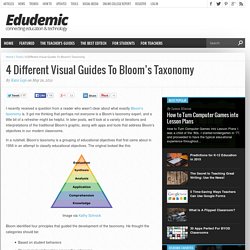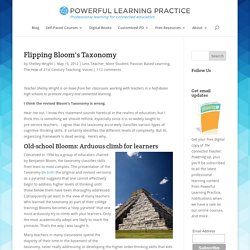

A New Wonderful Bloom's Taxonomy Visual for Teachers. Bloom's Digital - Web 2.0. 4 Different Visual Guides To Bloom's Taxonomy. I recently received a question from a reader who wasn’t clear about what exactly Bloom’s taxonomy is.

It got me thinking that perhaps not everyone is a Bloom’s taxonomy expert, and a little bit of a refresher might be helpful. In later posts, we’ll look at a variety of iterations and interpretations of the traditional Bloom’s graphic, along with apps and tools that address Bloom’s objectives in our modern classrooms. In a nutshell, Bloom’s taxonomy is a grouping of educational objectives that first came about in 1956 in an attempt to classify educational objectives. The original looked like this: Bloom identified four principles that guided the development of the taxonomy. Based on student behaviorsShow logical relationships among the categoriesReflect the best current understanding of psychological processesDescribe rather than impose value judgments As with everything in life, times changed/things progressed/humans evolved, and another version was created in 2000.
Pinterestblooms-page-001-2.jpg (2148×2148) 25 Ways To Use Pinterest With Bloom’s Taxonomy. Teacher's Guide to The Use of Blooms Taxonomy in The Classroom. Flipping Bloom’s Taxonomy. Teacher Shelley Wright is on leave from her classroom, working with teachers in a half-dozen high schools to promote inquiry and connected learning.

I think the revised Bloom’s Taxonomy is wrong. Hear me out. I know this statement sounds heretical in the realms of education, but I think this is something we should rethink, especially since it is so widely taught to pre-service teachers. I agree that the taxonomy accurately classifies various types of cognitive thinking skills. It certainly identifies the different levels of complexity. Old-school Blooms: Arduous climb for learners Conceived in 1956 by a group of educators chaired by Benjamin Bloom, the taxonomy classifies skills from least to most complex. Many teachers in many classrooms spend the majority of their time in the basement of the taxonomy, never really addressing or developing the higher order thinking skills that kids need to develop.
Here’s what I propose. Blooms 21: Let’s put Creating at the forefront. Coolcatteacher.sharedby.co/share/6A9aNq. Teaching in the 21st Century. Subscribe to Anders Bobäck Get the best videos sent to your inbox Thanked Anders Bobäck 22mo Teaching in the 21st Century.

Two Great Blooms Taxonomy Posters for Teachers. Blooms Taxonomy is another topical theme I keep writing about here in Educational Technology and Mobile Learning whenever I stumble upon a new resource.

I love this taxonomy and I always insist on its importance in learning , particularly in organizing the teaching content in such a way to enhance and promote those higher order thinking skills we all our students to develop. Use it like a roadmap to guide you through the different areas of your lesson planning. If you are a new teacher and need to learn more about this taxonomy I recommend you read this guide first. Today I am sharing with you a really wonderful poster created by iLearn Technology ( one of my favourite EdTech Blogs and one that I highly recommend for you ). Here is what Kelly has to say to you about it : "I want to show teachers that just because these activities help students practice basic skills and remember and understand, there are SO many more options that will reach the higher levels of Bloom’s Taxonomy!